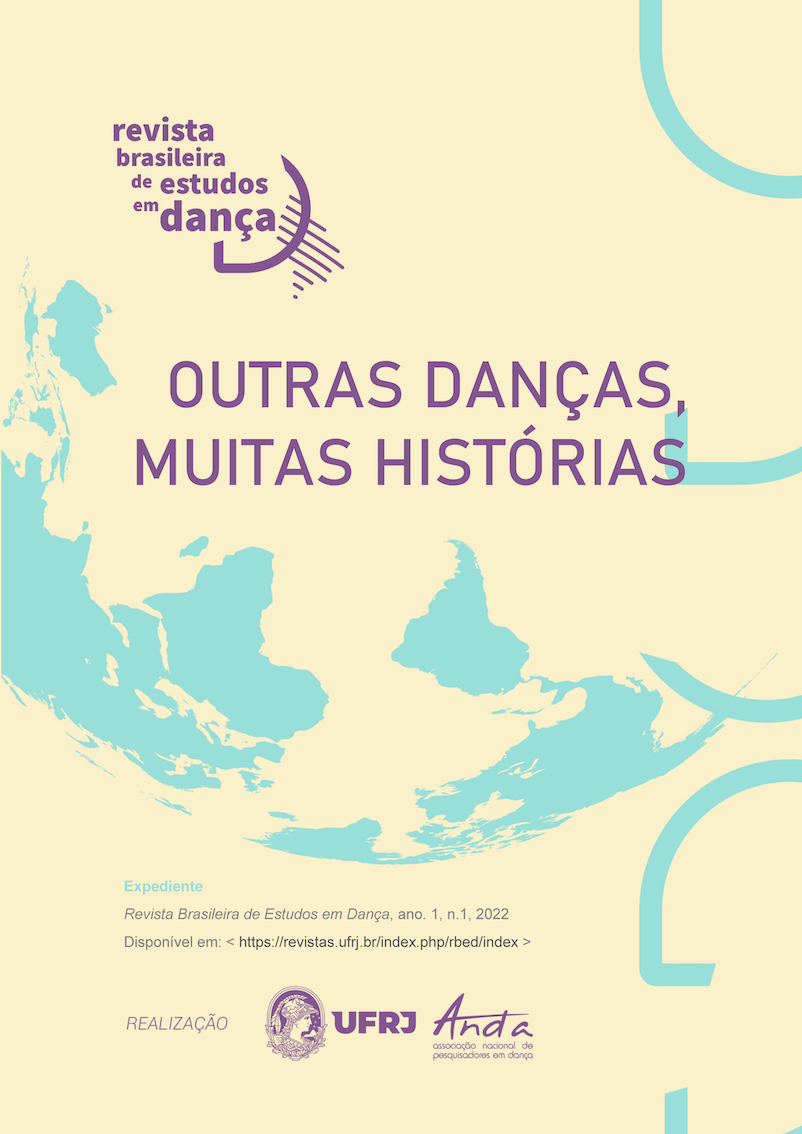Flashes between worlds and bodies:
From colonial historiography in Mesoamerica to an anti-colonial, speculative, and pluriversal applied historiology
DOI:
https://doi.org/10.58786/rbed.2022.v1.n1.52364Keywords:
dance, performance, Dance historiographies, coloniality, de-colonialityAbstract
This collaboration between the three authors consists of a set of "flashes" (critical juxtapositions) that reveal insights about the "sui generistransmotions" that Gerald Vizenor defined as the inherent right of movement. Analysing the mechanisms and logics of corpo-ontological destruction in Mesoamerica, this essay names the distinct sociological relations between the three authors and how these relations shape their collaboration. Guarcax González narrates details of his sound/movement practice with Grupo Sotzil, while Brito Bernal interrogates the archaeological record of dance in Central Americato reflect on its purposes. Firmino-Castillo concludes by presenting diasporic movement projects that are animated by their persistent ontological relationalities. At the same time, these approaches critically address both the past and the present in order to speculate upon paths towards the future. Firmino-Castillo concludes by arguing that these approaches are historiographical, but also historiological in their possible anti-colonial applications
References
BARRIOS, Lina E. Alcaldía Indígena en la Época Colonial. Ciudad de Guatemala, Guatemala: Universidad Rafael Landívar, Instituto de Investigaciones Económicas y Sociales, 1996.
BENJAMIN, Walter. Das Passagen-Werk (The Arcades Project). Traducido por Howard Eiland y Kevin McLaughlin. Cambridge, Massachusetts: Belknap Press / Harvard University Press, 1999 (2002).
BENJAMIN, Walter. Selected Writings, Volume 4 (1938-1940). Traducido por E. Jephcott y otros. Editado por H. Eiland y M.W. Jennings. Cambridge, Massachusetts: Harvard University Press, 1940 (2003).
BLU WAKPA, Makha. Cyclical Continuity and Multimodal Language Planning for Indigenous North America. 171 pages. Doctoral Dissertation. Department of Teaching, Learning, and Sociocultural Studies. University of Arizona. Phoenix, 2017. https://repository.arizona.edu/handle/10150/626148
FIRMINO CASTILLO, María Regina; GUARCAX GONZALEZ, Daniel Fernando y Tohil Fidel BRITO BERNAL. “Beyond the Border: Embodied Mesoamerican Transmotions.” Movement Research Performance Journal. New York, NY. (Special Issue #52/53) Sovereign Movements: Native Dance and Performance, guest edited by Rosy Simas and Ahimsa Timotéo Bodhran. pág. 34-41. 2019. https://movementresearch.org/publications/performance-journal/issue-52-53. Accedido 7 mayo 2022.
FORENSIC ARCHITECTURE. “Genocide in the Ixil Triangle.” 2014. Disponible en: https://forensic-architecture.org/investigation/environmental-violence-and-genocide-in-the-ixil-triangle#resources. Accedido 7 mayo 2022.
GÓMEZ-PEÑA, Guillermo. The New World Border: Prophecies, Poems, & Loqueras for the End of the Century. San Francisco, California: City Lights, 1996.
GRUPO SOTZ’IL. Ati’t Xajoj. Ciudad de Guatemala, Guatemala: Cholsamaj, 2015.
JACKSON, Zakiyyah Iman. Becoming Human: Matter and Meaning in an Antiblack World. New York, New York: New York University Press, 2020.
KLIËN, Michael and Steve Valk. “What Do You Choreograph at the End of the World?” In Zodiak: Unden Taussin Taehen. Like, Finland, 2007. Disponible en: http://www.michaelklien.com/onchoreography.html. Accedido 18 febrero 2019.
LIJSTER, Thijs. “Corresponding Catastrophes – Walter Benjamin on Allegory and History.” en Tickle your catastrophe: Imaging catastrophe in art, architecture, and philosophy. Editado por Frederick R. Le Roy, Nele Wynants, Dominiek Hoens, y Robrecht Vanderbeeken. Thorn, The Netherlands: Academia Press – studies in performing arts & media #9. 2011. pág. 63-74.
LOIS, Ximena and Valentina Vapnarsky, et al. “Polycategoriality and Hybridity Across Mayan Languages: Action Nouns and Ergative Splits.” In Lexical Polycategoriality: Cross-linguistic, cross-theoretical and language acquisition approaches. Eds. Valentina Vapnarsky, Edy Veneziano. Volume 182 of Studies in Language Companion Series. Amsterdam: John Benjamins Publishing Company, 2017. pág. 101–153. Disponible en: https://benjamins.com/catalog/slcs.182.05loi. Accedido 9 mayo 2022.
LOOPER, Matthew G. To Be Like Gods: Dance in Ancient Maya Civilization. Austin, Texas: University of Texas. 2009.
MARTÍ, Samuel. Mudra: manos simbólicas en Asia y América. Ciudad de México, México: Litexa, 1971 (2000).
PENSKY, Maxim. "Method and Time: Walter Benjamin's Dialectical Images," en The Cambridge Companion to Walter Benjamin. David Ferris, editor. Cambridge, Massachusetts: Cambridge University Press, 2004. pág. 177-198.
ROMERO, Sergio. “Language, Catechisms, and Mesoamerican Lords in Highland Guatemala: Addressing ‘God’ after the Spanish Conquest.” Ethnohistory 62:3. 2015. pág. 623-649. DOI 10.1215/00141801-2890273
SCOLIERI, Paul. Dancing the New World: Aztecs, Spaniards, and the Choreography of Conquest. Austin: University of Texas Press, 2013.
SOLÓRZANO FONSECA, Juan Carlos. “Pueblos de indios y explotación en la Guatemala y El Salvador coloniales.” In Anuario de Estudios Centroamericanos. 8: 125-113. 1982. Disponible en: DOI: https://doi.org/10.15517/aeca.v8i1.3288. Accedido 12 diciembre 2019.
TAYLOR, Diana. The Archive and the Repertoire: Performing Cultural Memory in the Americas. Chapel Hill, North Carolina: Duke University Press, 2003.
VON ARB, Justine. "The Changing Nature of Catastrophe: A History of Semantic Shift." Honors Program Projects. 84. 2016. Disponible en: https://digitalcommons.olivet.edu/honr_proj/84. Accedido 6 mayo 2022.
VALENCIA RIVERA, Rogelio. “The Politics of Dancing.” In Socio-Political Strategies among the Maya from the Classic Period to the Present: An introduction. Veronica Vasquez, Rogelio Valencia Rivera, Eugenia Gutierrez, Eds. Oxford, UK: Archaeopress / British Archaeological Reports, 2014.
VIZENOR, Gerald. Fugitive Poses. Native American Indian Scenes of Absence and Presence. Lincoln, Nebraska y London, UK: University of Nebraska Press, 1998 (2000).
WITTE, Bernd. Walter Benjamin: An Intellectual Biography. Detroit, Michigan: Wayne State University Press, 1996.
Downloads
Published
Versions
- 2024-05-10 (3)
- 2023-11-30 (2)
- 2022-07-15 (1)
How to Cite
Issue
Section
License
Authors who publish in the Revista Brasileira de Estudos em Dança are
responsible for the content of signed articles and retain copyright.
They grant the journal the right of first publication with the work simultaneously
licensed under the Creative Commons Attribution-NonCommercial 4.0 License
(Open Archives Initiative - OAI). This feature, used for open-access journals,
allows sharing work for non-commercial purposes and acknowledges
authorship. If the text is later published in another vehicle, the author
must inform that it was initially published as an article in the Revista Brasileira
de Estudos em Dança. Therefore, even if the journal owns the first publication,
authors are entitled to publish their work in institutional repositories or on
their personal pages, even if the editorial process has not been completed.
The journal reserves the right to make normative, orthographic, and grammatical changes to maintain the language standard, respecting the authorial style.

